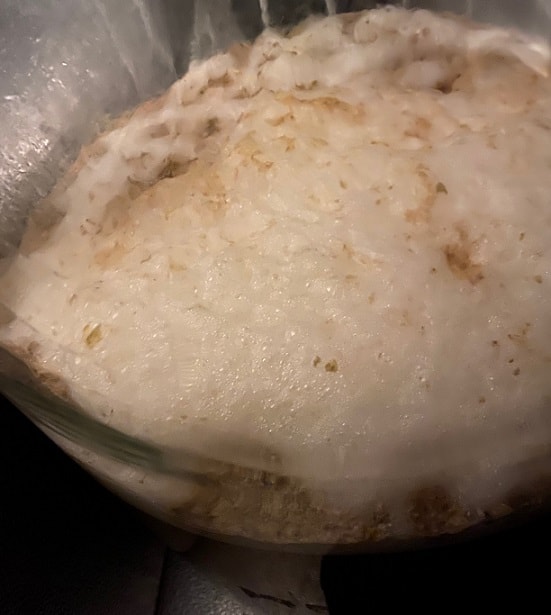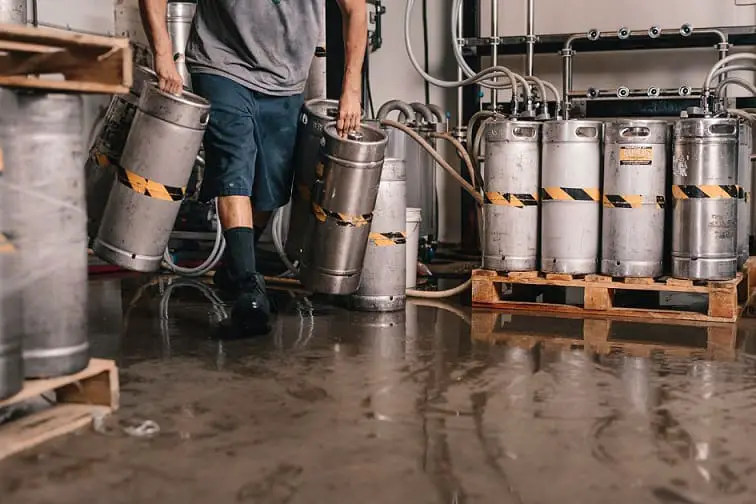We recently got a hop basket which is great for reducing trub. Problem is now that there is less trub, I’m wondering if the increased headspace will negatively affect the beer.
A carboy should not be filled completely, some space should remain for fermentation to take place. A 6 gallon carboy should be used for a 5 gallon recipe. The extra headspace is only detrimental when fermenting for long periods of time, 1 month is not enough time for oxidation to take place.
Oxidation can become an issue if you are trying to age your beer for a long period of time. Making sure to reduce the head space will ensure you beer will last as long as possible, but how much of a problem is oxidation in beer anyways?
Headspace in a Carboy
When it comes to headspace in a Carboy it really doesn’t matter too much for beer. Especially in primary fermentation.
During primary fermentation there is so much yeast activity the beer has a protective layer of foam or krausen. This keeps the beer protected against oxidation.

One positive of having more headspace during the primary fermentation is you may not need a blow off tube.
A blow off tube is required when you don’t have much headspace left in your carboy since there less space for CO2 to sit while it waits to escapie via the bubbler.

Some fermentation is more vigorous, it really depends on the yeast you are using. But for these vigorous fermentations, headspace is important to keep pressure from building too much and blowing off the top.
Headspace During Secondary Fermentation
When it comes to secondary fermentation headspace starts to become a negative for a few reasons.
- Oxidation can take place since there is no protective layer of foam.
- Longer aging can slowly oxidize the beer.
Oxidation is most detrimental to overly hoppy beers. This is mainly why IPA’s generally have a shorter shelf life than beers with less hops.
This is why its not suggested to age IPA’s in secondary, especially if there is a lot of headspace.
One way around this issue is to do your secondary fermentation in a keg. This will allow you to purge the keg of oxygen and inject CO2. This is a great way to keep any beer fresh during secondary fermentation.

Long Secondary Fermentation
If you plan on aging your beer for a long period of time, like 6 months or more than you really need to start worrying about headspace in your beer.
This means making sure no oxygen gets in the headspace for your fermentation, this can be ton with tools that will help push the oxygen out of your carboy.
This can essentially be done by injecting CO2 into the headspace, since CO2 is heavier than oxygen the oxygen will be pushed out as the CO2 sits in the carboy.
Typically most be will not need to be aged for long periods of time, but for some beers with a higher alcohol content, longer aging makes sense as it mellows out and the flavors mix.
When aging these higher alcohol beers be especially careful if you are adding anything extra, like fruit or spices. Not only will you risk contamination but the chance of oxidation is also great.
What Does Oxygenation Taste Like
If your beer gets oxygenated it won’t taste as crisp or flavorful as it would otherwise. It will have a stale flavor to it that is sort of like a bag of stale chips. Some even describe it as a wet cardboard taste.
At the end of the day oxygenated beer will have an off taste that may cause you do have to dump it. But beers can have oxygenation problems and still be good enough to drink.
Don’t be afraid that oxygenated beer its not overly common for homebrewers since the fermentation time is so short.
I’m sure I’ve tasted a beer with oxygenation issues, and thought nothing of it, other than it not being all that great.
NEIPA Oxidation
NEIPA or New England IPA, has a very interesting color that takes place if the beer gets oxigenated.
It actually turns purple!
This is a pretty telltale sign that your NEIPA has been oxygenated. To reduce this make sure not to splash your beer around in secondary fermentation and keep headspace in a keg purged of all oxygen.
If you decide to dry hop, take special care to purge any oxygen in your carboy.
Check out my article on building your very own New England IPA if you are interesting in making your own beer.
Fermentation Bucket vs Carboy
There are two methods of undergoing fermenation. You can either ferment in a bucket or a carboy and there are benefits to both.
Carboy fermentation generally has less headspace and more of a need for a blow-off tube, this can be a little more tedious than fermenting in a bucket that has plenty of headspace.
Bucket fermentation is also better if you don’t plan on doing anything to the beer during primary fermentation. However, bucket fermentation can be tricky since you can’t see the beer and have to open the top to see if any fermentation is taking place.
A lot of homebrewers ferment in a bucket during primary, but almost always switch to a carboy for secondary fermentation.
It’s likely because most of the reasons for transferring to secondary are for clarification. And whats the point of checking out year clear brew if its in an opaque bucket instead of a clear carboy.
Oxidation is bad but Oxygenated Wort is Good
So, all this talk about headspace in a carboy and the pitfalls of oxidation has got you thinking oxygen is the enemy, but in reality its very important.
You see, yeast loves oxygen in the wort, and its needed!
There is a difference between oxygen in wort and oxidation issues that can make your beer go bad. You actually need to inject oxygen into the wort before primary.
This can be done in a few ways. Either by using a pump to push oxygen into the wort, or by shaking your wort around in its container.
Shaking the wort will rid the vessel of oxygen within the headspace and push it into the wort. In turn the yeast will use this oxygen to turn your wort into beer.
After the wort turns into beer, the oxygen in the wort also gets used up and rids the wort of oxygen.
While, its important to make sure your wort has specific levels of oxygen for the perfect fermentation to take place, its not something homebrewers need to worry about.
I have not paid attention to oxygenating my wort at all and constantly have delicious brews.
Conclusion in Beer Oxidation
While you need to worry about oxidation in longer fermentations and heavily hopped IPA’s its not that much of a problem with beer.
Oxidation is more of a fear if you are homebrewing mead, or in the wine-making process.
However, while oxidation is not a general fear in beer making, you absolutely should keep headspace in check. Don’t brew a small batch beer using an over-sized fermentation bucket or carboy.
The greater the oxygen exposure, the higher the potential for negative effect on your beer.
Oxygenation is also not much of an issue during the initial fermentation process, and many breweries actually practice open fermentation with now lid whatsoever.
The CO2 that is produced from the fermentation process will push out any oxygen trying to make its way into the beer.
Thanks for reading and happy brewing!
